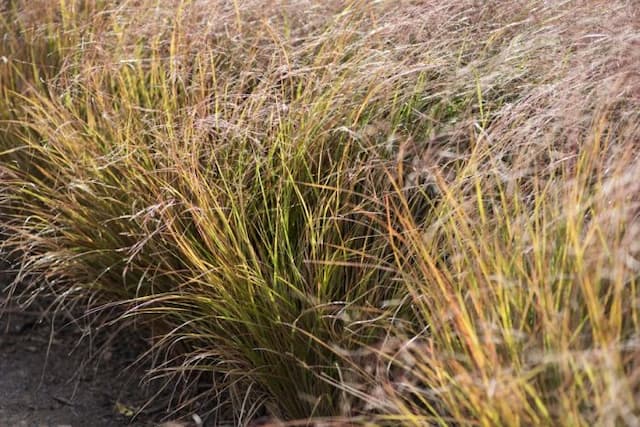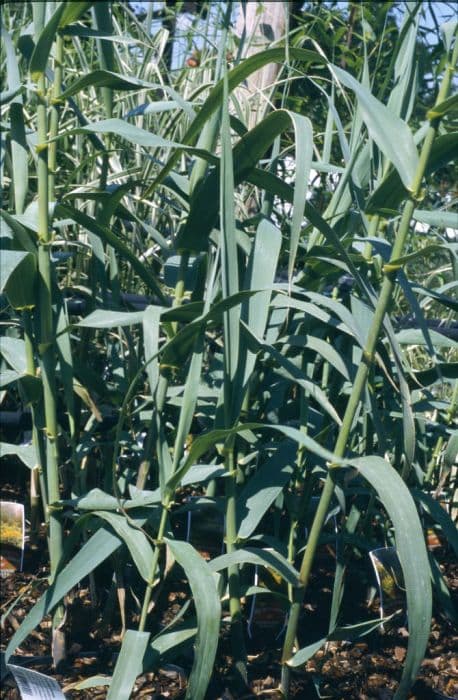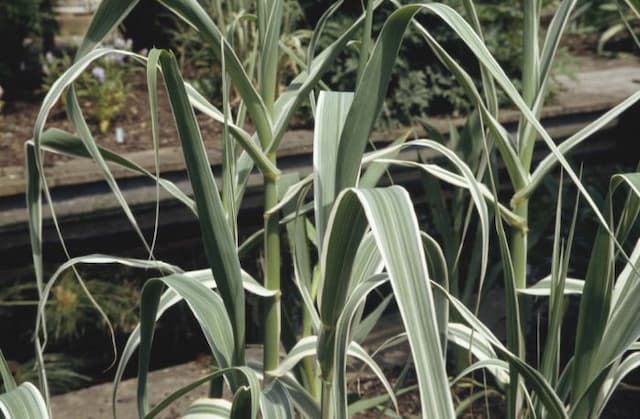Siberian melic Melica altissima 'Alba'

ABOUT
Melica altissima 'Alba', commonly known as Tall Melic or Siberian melic grass, is a perennial grass that is notable for its elegant and graceful appearance. This plant features slender, arching leaves that tend to have a soft, green hue. The foliage provides a backdrop for the attractive flower spikes. What stands out are its delicate flower plumes that are an ethereal white, offering a sense of lightness and airiness to the plant’s structure. These feathery flower spikes create a hazy, almost frosted look when they catch the light, which can add a magical touch to gardens. The flowers of this variety of Tall Melic are particularly noteworthy for their pure white coloration and the way they rise above the foliage, gently swaying in the breeze. As they mature, the flowers take on a slightly translucent quality, which can be quite radiant in the soft light of morning or late afternoon. The leaves are narrow and long, contributing to the overall soft texture of the plant. During the growing season, the foliage remains a luscious green, providing a nice contrast to the whiteness of the blooms. In the fall, the leaves may change color adding seasonal interest to the plant's profile. Its overall form is clump-forming, with the tufts of grass creating a dense and tidy appearance at the base. The plant exudes a naturalistic charm and is often used in gardens for its ability to blend with a variety of other plants and landscape styles, ranging from formal to wild meadows.
About this plant
 Names
NamesFamily
Poaceae.
Synonyms
Tall Melic, Siberian Melic Grass.
Common names
Melica altissima 'Alba'
 Toxicity
ToxicityTo humans
There is limited information available on the toxicity of the Tall Melic Grass (Melica altissima 'Alba') to humans. Generally, this ornamental grass is not known to be toxic and does not typically cause poisoning when touched or ingested. However, it is always advisable to exercise caution and avoid ingesting any plant material that is not known to be safe for consumption.
To pets
The Tall Melic Grass (Melica altissima 'Alba') is not commonly listed as toxic to pets such as dogs and cats. This ornamental grass does not usually pose a risk of poisoning if pets come into contact with it or consume small amounts. Nevertheless, pet owners should always monitor their pets and prevent them from eating large quantities of any non-food plants, as they can sometimes cause gastrointestinal upset or other non-toxic reactions due to the plant's fiber content or other non-toxic compounds.
 Characteristics
CharacteristicsLife cycle
Perennials
Foliage type
Deciduous
Color of leaves
Green
Flower color
White
Height
2-3 feet (60-90 cm)
Spread
1-2 feet (30-60 cm)
Plant type
Herb
Hardiness zones
5
Native area
Europe
Benefits
 General Benefits
General Benefits- Adds ornamental value: The Melica altissima 'Alba', commonly known as Tall White Melic, produces elegant white flowers that can enhance the aesthetic appeal of gardens and landscapes.
- Attracts wildlife: Flowers and seeds may attract birds and beneficial insects, supporting local biodiversity.
- Drought tolerance: Once established, it can tolerate periods of dryness, reducing the need for frequent watering.
- Low maintenance: This grass requires minimal care once established, limiting the need for fertilizers or pesticides.
- Adaptable to various soils: It can thrive in a range of soil types, from well-drained sandy soils to heavier clays.
- Seasonal interest: With its attractive foliage and blooms, it provides visual appeal from late spring to summer and adds interest with its seed heads in fall and winter.
- Erosion control: The root system helps stabilize the soil and prevent erosion on slopes and in other vulnerable areas.
- Use in naturalistic plantings: Ideal for naturalized or wildflower gardens where a less manicured aesthetic is desired.
- Non-invasive: Unlike some ornamental grasses, Tall White Melic is not known to be invasive, making it a responsible choice for conscientious gardeners.
 Medical Properties
Medical PropertiesThis plant is not used for medical purposes.
 Air-purifying Qualities
Air-purifying QualitiesThis plant is not specifically known for air purifying qualities.
 Other Uses
Other Uses- Melica altissima 'Alba', commonly known as Siberian melic, can be used in basket weaving due to its long, flexible stems.
- The plumes of Siberian melic can be used for decorative purposes in floral arrangements and bouquets.
- Siberian melic grass can be used in crafting for activities like wreath making when dried, adding a unique texture to the final product.
- This plant can be used as a natural dye source, where various parts of the plant may produce different shades on fabrics.
- The dried stems of Siberian melic can be used in homemade paper making, incorporating plant fibers into the paper for added interest.
- In landscapes, Siberian melic can be used in erosion control because its roots help to stabilize the soil.
- The plant can be used as a living mulch, as it provides ground cover that helps retain soil moisture and suppress weeds.
- Siberian melic can be incorporated into a wildlife garden to provide habitat and food for certain bird species who feed on the seeds.
- The plant is sometimes used in sound buffering arrangements in gardens adjacent to noisy areas, as the foliage can help reduce sound penetration.
- As an ornamental grass, Siberian melic can be used in winter gardens, where its dried form adds interest to a barren landscape.
Interesting Facts
 Feng Shui
Feng ShuiThe Tall White Melick is not used in Feng Shui practice.
 Zodiac Sign Compitability
Zodiac Sign CompitabilityThe Tall White Melick is not used in astrology practice.
 Plant Symbolism
Plant Symbolism- Elegance: Melica altissima 'Alba', commonly known as Tall White Melic, is often associated with elegance due to its tall, graceful stems and delicate white flowers.
- Peace: The white color of the flowers is symbolic of peace and calm, making it a plant that's commonly used to evoke a sense of serenity in gardens.
- Purity: White flowers are traditionally linked to purity and innocence, and the Tall White Melic is no exception. It can represent clean and pure thoughts.
- Simplicity: The Tall White Melic's simple and unadorned flowers can symbolize the beauty and simplicity of nature, and a life unburdened by complexity.
- Adaptability: Since Melica altissima 'Alba' can thrive in a variety of conditions, it is often seen as a symbol of adaptability and resilience.
 Water
WaterThe White Melic Grass should be watered deeply to encourage root development, but allow the soil to dry out slightly between waterings. Generally, watering once a week with approximately 1 to 1.5 gallons of water should be sufficient, but this could vary based on climate and soil conditions. During hot or dry periods, this may need to be increased to twice a week. Cut back on watering in the fall to prepare the plant for winter dormancy, and resume regular watering in the spring as new growth appears.
 Light
LightThe White Melic Grass thrives best in full sun to partial shade conditions. An ideal spot would provide at least 4 hours of sun daily, with some afternoon shade in extremely hot climates to protect the plant. Avoid deep shade locations as this will diminish its vigor and flowering potential.
 Temperature
TemperatureThe White Melic Grass can tolerate a wide range of temperatures once established, ideally between 60°F and 75°F. It can survive minimum temperatures down to about -20°F and is hardy up to USDA zone 5. To ensure vigorous growth, protect it from extreme heat or cold exposure by situating it in a location that avoids the harsh afternoon sun in very hot climates and provides some insulation from frost in colder regions.
 Pruning
PruningThe White Melic Grass should be pruned to remove dead or faded foliage and to maintain its shape, typically done in late winter or early spring before new growth starts. Cut the grass back to about 4 inches above the ground every year. This encourages healthy, fresh growth and prevents the plant from becoming too woody and unattractive.
 Cleaning
CleaningAs needed
 Soil
SoilTall White Melic grass prefers well-draining, fertile soil with added organic matter. Ideal soil pH for Tall White Melic grass ranges from slightly acidic to neutral, around pH 5.5 to 7.0. For the best soil mix, combine garden soil, compost, and perlite or sand to ensure good drainage and fertility.
 Repotting
RepottingTall White Melic grass doesn't often require repotting as it's normally grown as an outdoor perennial. However, if grown in containers, repot every 2-3 years to refresh the soil and accommodate root growth.
 Humidity & Misting
Humidity & MistingTall White Melic grass tolerates a wide range of humidity levels and does not have specific humidity requirements. It is relatively adaptable, but aiming for moderate ambient humidity will support its growth.
 Suitable locations
Suitable locationsIndoor
Place it in bright, indirect light and water regularly.
Outdoor
Full sun to partial shade, with moist, well-drained soil.
Hardiness zone
5-9 USDA
 Life cycle
Life cycleTall White Melica (Melica altissima 'Alba') starts its life as a seed, which germinates in the soil in spring when the temperature and moisture levels are favorable. The seedling then develops into a young plant with a rosette of leaves close to the ground. As it matures, it forms upright stems and foliage, followed by the emergence of delicate, plume-like white flowers that bloom in late spring to early summer. After pollination, the flowers develop into grains that contain the seeds, completing the reproductive phase. Once seeds have dispersed, the plant enters a period of dormancy in late autumn and winter. This perennial grass re-emerges from the same root system each spring, continuing its life cycle for several years.
 Propogation
PropogationPropogation time
Spring to Summer
For the white melic grass (Melica altissima 'Alba'), the most popular method of propagation is by division, typically done in the spring. This process involves carefully digging up an established clump of the grass once the risk of frost has passed and the grass is beginning to show active growth. The clump should then be gently separated into smaller sections, ensuring that each new piece has a portion of the root system. These divisions can then be immediately replanted in well-prepared soil, spaced about 12 to 18 inches (approximately 30 to 45 centimeters) apart to allow for growth. Regular watering after planting helps the new divisions to establish quickly. This method is favored for its simplicity and effectiveness in creating new plants that are true to the parent’s characteristics.









